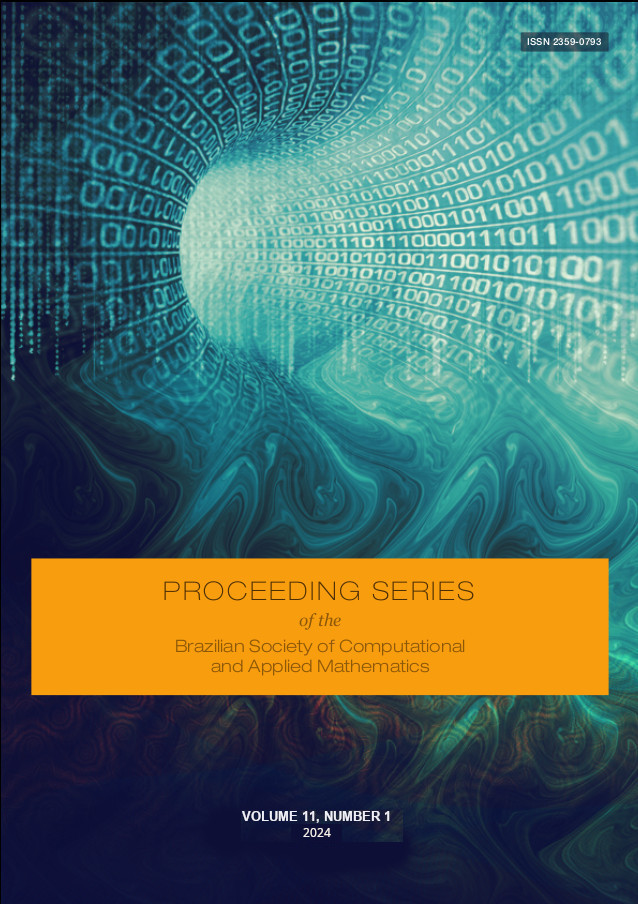Mathematical model of the interaction of pathogenic bacteria and bacteriophages
DOI:
https://doi.org/10.5540/03.2025.011.01.0425Palabras clave:
Coliphages, E.coli, phage-bacteria, Lyapunov method, population dynamicsResumen
We present a mathematical model employing ordinary differential equations to model the interaction dynamics between bacterial pathogens and Bacteriophages. Our model incorporates a non-linear function with inhibitory effects to describe the infection dynamics within these populations. By utilizing the Lyapunov theory and the second additive compound matrix, we analyze the stability of the model. Additionally, a global sensitivity analysis is conducted to identify the most influential parameters. Parameter estimation is performed using growth data of Escherichia coli (E. coli) bacteria in the presence of Coliphages, which are bacteriophages targeting E. coli, at various levels of multiplicity of infection. Our findings reveal a critical threshold that determines whether bacteriophage concentration will lead to coexistence with the bacterium or extinction of the phages. The coexistence equilibrium is found to be locally asymptotically stable, while the phages extinction equilibrium is globally asymptotically stable, contingent upon the magnitude of this threshold. Furthermore, our analysis indicates that the infection rate of bacteria and the half-saturation phage density significantly influence the dynamics of the model. Importantly, our parameter estimation demonstrates the effectiveness of all multiplicities of infection in eliminating infected bacteria, albeit with smaller multiplicities resulting in a higher residual population of bacteriophages post-elimination.
Descargas
Citas
G. Beke, M. Stano e L. Klucar. “Modelling the interaction between bacteriophages and their bacterial hosts”. Em: Math. Biosci. 279 (2016), pp. 27–32. doi: 10.1016/j.mbs.2016.06.009.
B. J. Cairns, A. R. Timms, V. A. Jansen, I. F. Connerton e R. J. Payne. “Quantitative models of in vitro bacteriophage–host dynamics and their application to phage therapy”. Em: PLoS Pathog. 5 (2009), e1000253. doi: 10.1371/journal.ppat.1000253.
J. R. Clark e J. B. March. “Bacteriophages and biotechnology: vaccines, gene therapy and antibacterials”. Em: Trends Biotechnol. 24 (2006), pp. 212–218. doi: 10.1016/j.tibtech.2006.03.003.
M. R. Clokie, A. D. Millard, A. V. Letarov e S. Heaphy. “Phages in nature”. Em: Bacteriophage 1 (2011), pp. 31–45. doi: 10.4161/bact.1.1.14942.
A. M. Comeau, G. F. Hatfull, H. M. Krisch, D. Lindell, N. H. Mann e D. Prangishvili. “Exploring the prokaryotic virosphere”. Em: Res. Microbiol. 159 (2008), pp. 306–313. doi: 10.1016/j.resmic.2008.05.001.
M. C. Gómez e H. M. Yang. “Mathematical model of the immune response to dengue virus”. Em: J. Appl. Math. Comput. 63 (2020), pp. 455–478. doi: 10.1007/s12190-020-01325-8.
I. U. Haq, W. N. Chaudhry, M. N. Akhtar, S. Andleeb e I. Qadri. “Bacteriophages and their implications on future biotechnology: a review”. Em: Virol. J. 9 (2012), pp. 1–8. doi: 10.1186/1743-422X-9-9.
C. Howard-Varona, K. R. Hargreaves, S. T. Abedon e M. B. Sullivan. “Lysogeny in nature: mechanisms, impact and ecology of temperate phages”. Em: ISME J. 11 (2017), pp. 1511–1520. doi: 10.1038/ismej.2017.16.
R. Jain, A. L. Knorr, J. Bernacki e R. Srivastava. “Investigation of bacteriophage MS2 viral dynamics using model discrimination analysis and the implications for phage therapy”. Em: Biotechnol. Progr. 22 (2006), pp. 1650–1658. doi: 10.1021/bp060161s.
M. Konopacki, B. Grygorcewicz, B. Dolegowska, M. Kordas e R. Rakoczy. “Phagescore: A simple method for comparative evaluation of bacteriophages lytic activity”. Em: Biochem. Eng. J. 161 (2020), p. 107652. doi: 10.1016/j.bej.2020.107652.
C. Loc-Carrillo e S. T. Abedon. “Pros and cons of phage therapy”. Em: Bacteriophage 1 (2011), pp. 111–114. doi: 10.4161/bact.1.2.14590.
S. Marino, I. B. Hogue, C. J. Ray e D. E. Kirschner. “A methodology for performing global uncertainty and sensitivity analysis in systems biology”. Em: J. Theor. Biol. 254 (2008), pp. 178–196. doi: 10.1016/j.jtbi.2008.04.011.
H. Ndongmo Teytsa, B. Tsanou, S. Bowong e J. M. Lubuma. “Bifurcation analysis of a phage-bacteria interaction model with prophage induction”. Em: Math. Med. Biol. 38 (2021), pp. 28–58. doi: 10.1093/imammb/dqaa010.

